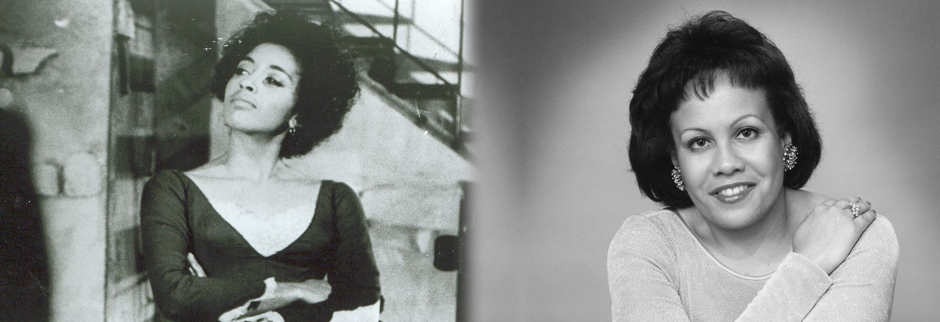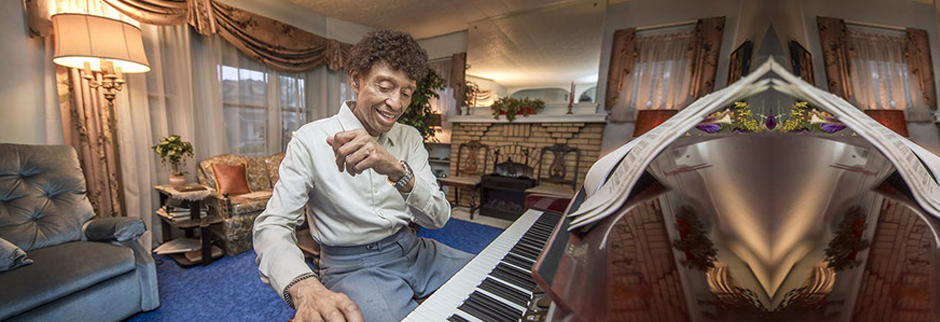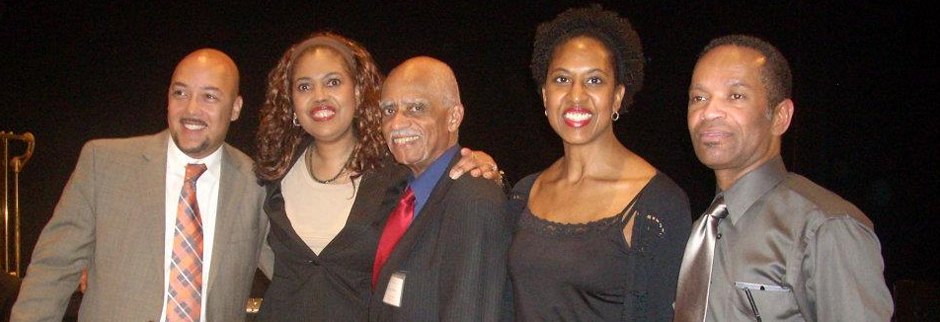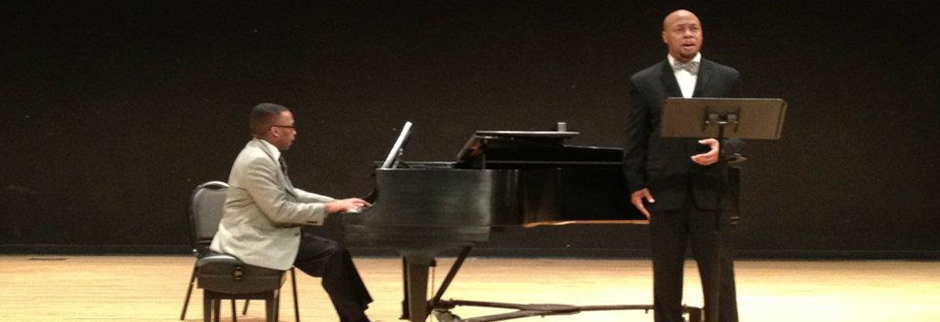The African American Composers and Performers of Art Song: The19th and 20th Century - Stage 4 and 5 Development
African American contributions to the Art Song Genre clearly emerge within the 19th century, Stage 4 of the Caldwell African Diaspora Framework, during the period of Emancipation and Institution-Building.
- 1860s African American singers begin to be connected with the genre of opera, a connection that continues throughout the 20th century. (Note that the major venue for opera, the Metropolitan Opera Company of New York City, opens in 1883, but does not offer a contract to an African American singer until 1955. The African American singer begins by performing opera as part of African American opera companies and as performers in works written by African American composers often using librettos that depict aspects of Black history. Additionally, the singers build careers in Europe. In other instances, they include opera arias within their concert programs. As a result, for the African American singer, the two genres opera and art song are essential components of their repertoire.)
- 20th Century - marked by a continuous expansion in the numbers of composers and professional concert singers.
- African American Composers and Performers of the Art Song Tradition 20th and 21st Century Performance Practice Debates
- What is the appropriate use of dialect?
- Is there a Black sound?
- Does the bel canto sound typical of Art Song performance have a place within the Black Aesthetic?
- Does improvisation have an appropriate place within the Art Song structure of the concert spiritual?
- Does the popular use of melisma have an appropriate place within the Art Song structure?
- Should composers and arrangers utilize a contemporary musical vocabulary that minimizes the presence of recognizably African American musical characteristics?
1850 - 1911
The African American Performers and Composers of Art Song: 19th Century Classical Tradition
- The Musical Practices of Urban Blacks - Black prima donnas and male quartets flourish. Singers of this period include:
- Flora Batson Bergen The Queen of Song (1864 - 1906), soprano
- Thomas Bowers The Colored Mario, (c. 1826 - 1885)
- Sarah Sedgewick Bowers The Colored Nightingale
- Ednah E. Brown, soprano
- Inez and Estelle Pickney Clough, sopranos
- Maggie Porter Cole (1853 - 1943), soprano (member of original Fisk Jubilee Singers)
- Rosa and Sadie De Wolf, sopranos
- Theodore Drury, baritone
- Elizabeth Taylor Greenfield The Black Swan (1817 - 1876)
- Emma Azalia Hackley (1867 - 1922), soprano
- M. Hamilton Hodges (c. 1869 -1928), baritone
- Anna Madah (c. 1855 - 1925), soprano and Emma Louise Hyers (c. 1853 - 189?), contralto The Hyers Sisters Concert Company
- Sam B. Hyers, tenor
- Matilda Sissieretta Joyner Jones Black Patti (1869 - 1933), soprano
- William Lew (1865 - 1949) tenor - Lew Male Quartet
- Nellie Brown Mitchell (1845 - 1924), soprano
- Annie Pindell, the Black Nightingale, (c. 1834 - 1901), soprano
- Desseria Plato (d. 1907), mezzo-soprano
- William I. Powell, baritone
- Adelaide and Georgina Smith
- Amelia Tilghman, soprano
- Rachel Walker (1873 - 194?), the Creole Nightingale, soprano
- Harry Williams, tenor
- Marie Selika Williams (c. 1849 - 1937), the Queen of Staccato
- Sidney Woodward (1860 - 1924), tenor
- African American, Creole American and Anglo-African Composers of Song include
- Amanda Ira Aldridge (1866 - 1956)
- Samuel Coleridge-Taylor (1875 -1912) Anglo-African composer and conductor of London, known in the United States as `the black Mahler
- Harry Lawrence Freeman (1869 - 1954)
- Louis Moreau Gottschalk (1829 - 1869)
- Justin Holland (1819 - 1887) guitarist and composer
- Scott Joplin (1868 - 1917)
- Richard Milburn (b. 1817)
- Samuel Snaer (1835 - 1900)
Ground-breaking accomplishments and concerts include:
Groundbreaking accomplishments and concerts include:
- 1851 Debut concert of Elizabeth Taylor Greenfield, presented by the Buffalo Musical Association;
- March 31, 1853 Elizabeth Taylor Greenfield makes her New York debut at Metropolitan Hall;
- May 10, 1854 Elizabeth Taylor Greenfield gives a Command performance before Queen Victoria at Buckingham Palace;
- 1867 The Hyers sisters give their debut recital in Sacramento, California;
- October 6, 1871 The Jubilee choral tradition is born with the tour of the Fisk University Jubilee Singers. Many of the individual singers in these ensembles go on to develop professional careers, concertizing nationally and internationally;
- 1872 World Peace Jubilee at Boston includes performances by professional jubilee troupes;
- November 13, 1878 Marie Selika performs at the White House for President Rutherford Hayes;
- 1880s The Grand Star Concert Company and The Bergen Star Concert Company present African American singers;
- 1883 Marie Selika gives a Command performance before Queen Victoria;
- June 15, 1888 Sissieretta Jones makes her New York debut at Steinway Hall;
- February 1892 Sissieretta Jones performs at the White House for President Benjamin Harrison;
- 1893 Sissieretta Jones performs at the Chicago Worlds Fair;
- 1893 Sidney Woodward gives his debut recital in Boston;
- 1895 Sissieretta Jones gives a debut concert in Berlin;
- November, 1898 Performance of Samuel Coleridge-Taylors Hiawathas Wedding Feast, the first of a trilogy of works based upon the poems of Henry Wadsworth Longfellow.
- 1903/04 Washington, D.C. performances of Samuel Coleridge-Taylors Hiawatha Trilogy.
- Opera and The Art Song. African American composers and impressarios develop an interest in the genre of opera during this 1850 - 1911 period, creating works and companies that feature the African American singer. However, venues and opportunities for performance are very limited.
- 1860s Elizabeth Taylor Greenfield organizes an opera troupe in Philadelphia;
- 1872 - The Colored Opera Company of Washington, D.C.;
- 1876 - The Hyers Sisters establish their Comic Opera Company;
- 1889 1910 The Theodore Drury Colored Opera Company;
- 1893 - Harry Lawrence Freeman composes The Martyr (premiered in Denver, Colorado). Additional operas by Freeman include Nada (1898), The Tryst (1911), Vendetta (1923), and Voodoo in 1928/29;
- 1898 - Samuel Coleridge-Taylor collaborates with Paul Laurence Dunbar in composing the opera Dream Lovers and again in 1908 to compose the three act opera, Thelma;
- 1903 - Scott Joplin composes A Guest of Honor;
- 1911 Scott Joplins opera, Treemonisha receives its first public performance;(professional premiere in 1971; 1972; 1975).
- The Composers and Singers of The Creole Show and Black Broadway
- Will Marion Cook (1869 - 1944)
- J. Rosamund Johnson
- Matilda Sissieretta Joyner Jones Black Patti (1869 - 1933) The Black Patti Troubadours/The Black Patti Musical Comedy Company a group of singers, dancers, comedians and jugglers performing shows such as A Trip to Africa, In the Jungles, Captain Jaspar, and Lucky Sam from Alabam.
Ground-breaking performances include:
- 1893 Will Marion Cook composes Scenes from the Opera of Uncle Toms Cabin for performance at the Chicago World�s Fair a performance that was cancelled;
- 1898 performance of Clorindy; or, The Origin of the Cakewalk, composed by Will Marion Cook in collaboration with Paul Laurence Dunbar.
COMMENTARY: The haze of complexional prejudice has so much obscured the vision of many persons, that they cannot see (at least, there are many who affect not to see) that musical faculties, and power for their artistic development, are not in the exclusive possession of the fairer-skinned race, but are alike the beneficent gifts of the Creator to all his children. Besides, there are some well-meaning persons who have formed, for lack of information which is here afforded, erroneous and unfavorable estimates of the art-capabilities of the colored race. - James M. Trotter, Music and Some Highly Musical People (Boston, 1878), p.4.
1900 - 1945
The African American Art Song: The Evolution, Preservation and Performance
- During this Period of Evolution, Preservation and Adaptation, composers begin to create a solo-voice, art-song repertoire inspired by the folk melodies of the Spiritual, and these works, known as The Concert Spiritual, become an important component of the performance repertoire of a growing number of professional African American singers. The tradition begins with Harry T. Burleighs 1916 arrangement of Deep River and Edward Boatners 1918 arrangement of Give Me Jesus. This body of song contributes to the creation of a style of American Nationalism in music. Much of the work of the African American composer and performer was celebrated, supported and preserved by the newly formed National Association of Negro Musicians (founded in 1919).
- Composers of the Renaissance
Renaissance A cultural, intellectual and social phenomenon of the 20th century in the United States in which African Americans become among the most prominent cultural and political personalities. The phenomenon is centered originally in Harlem, and has additional flowerings in Chicago and numerous other urban areas. It is a period that some observers describe as embracing the hope for black uplift and interracial interaction and empathy.
- Artists of this New Negro Movement use their work to enhance the public understanding of African American culture. African American composers embrace what is known as the Blues aesthetic within their work. Composers create many Art Songs, song cycles, operas and Creole shows utilizing the poetry of Harlem Renaissance poets, e.g. Arna Bontemps, Countee Cullen, Paul Laurence Dunbar, Langston Hughes. Composers of the 1900 - 1940 period include:
- Edward Hammond Boatner (1898 - 1981)
- Margaret Bonds (1913 - 1972)
- Harry Thacker Burleigh (1866 - 1949)
- Will Marion Cook (1869 - 1944)
- William Levi Dawson (1899 - 1990)
- Robert Nathaniel Dett (1882 - 1943)
- Roland Hayes (1887 - 1977)
- Francis Hall Johnson (1888 - 1970)
- J. Rosamond Johnson (1873 - 1954)
- Florence Beatrice Smith Price (1888 - 1953)
- Shirley Lola Graham DuBois
- William Grant Still (1895 - 1978)
- Clarence Cameron White (1880 - 1960)
COMMENTARY: The most difficult aspect of race prejudice for (William Grant) Stills development as a composer was the stereotype associated with African American musicians and their music. He described it this way: The stereotype may be defined as any preconceived idea as to what a Negro should or can do. Those hoping to climb to the top in serious music have had to contend with the idea that a Negros function is solely to sing spirituals, or to play jazz and clown . Quoted in the exhibition catalog for The Musical Renaissance of Black Los Angeles 1890 c. 1955, p. 50
- African American singers flourish (1900 - 1940), developing international careers. Singers of the period include:
- Marian Anderson (1897 - 1993), contralto
- Jules Bledsoe (1898 - 1943), baritone
- Edward Hammond Boatner (1898 - 1981)
- Anne Wiggins Brown (b. 1912 or 1915), soprano
- Anita Patti Brown
- Harry Thacker Burleigh (1866 - 1949)
- Celeste Cole (1907 - 1984), soprano
- Cleota Collins (1893 - 1976), soprano
- Ellabelle Davis, (1907 - 1960), soprano
- Carl Diton (1886 - 1962)
- Todd Duncan (1903 - 1998), baritone
- Ruby Elzy (1908 - 1943), soprano
- Lillian (Evans Tibbs) Evanti (1890 - 1967), soprano
- Carlotta Franzel-Frisby (1908 - 1984)
- Roland Hayes (1887 -1977), tenor
- Caterina Jarboro (1903 - 1986), soprano
- Yolanda Maddox (1897 - 1947)
- Abbie Mitchell (1884 - 1960), soprano
- Etta Moten Barnett (1901 - 2004), soprano
- Camille Nickerson (1887 - 1982)
- Muriel Rahn (1911 - 1961), soprano
- La Julia Rhea (1908 - 1992), soprano
- Paul Robeson (1898 - 1976), baritone
- Florence Cole Talbert-McCleave (1890 � 1961), soprano
- Camilla Williams (b. 1919), soprano
- Lawrence Winters, baritone
Ground-breaking accomplishments and performances (1900 - 1940) include:
- 1912 Composer Will Marion Cook publishes A Collection of Negro Songs;
- 1916 composer Harry T. Burleigh publishes an arrangement of the Spiritual Deep River, thus beginning the development of the Art Song Spiritual repertoire;
- 1919 The National Association of Negro Musicians is founded. Chapters emerge across the country, and the organization becomes an essential supporter of African American singers and composers.
- 1923 - concert by Roland Hayes, featuring a concluding section of Spirituals;
- 1923 Paul Robeson stars in All Gods Chillun Got Wings;
- April 19, 1925 - concert by Paul Robeson at the Greenwich Village Theatre in New York City the first concert to present a repertoire devoted entirely to the Spiritual;
- 1926 Roland Hayes gives a distinguished performance at Carnegie Hall;
- 1929 Contralto Marian Anderson gives her debut recital at Carnegie Hall;
- April 1931 Baritone Jules Bledsoe gives his debut recital at Carnegie Hall;
- January 31, 1933 Contralto Etta Moten Barnett performs at the White House;
- June 15, 1933 Roland Hayes performs excerpts from Samuel Coleridge-Taylors Hiawathas Wedding Feast at a program presented by the Chicago Symphony Orchestra;
- September 1933 April 1934 Marian Anderson concertizes throughout Europe (Denmark, Finland, Norway and Sweden);
- 1934 Soprano Lillian Evanti performs at the White House
- August 1935 Marian Anderson gives a recital in Salzburg after which conductor Arturo Toscanini describes her voice as a voice like yours is heard once in a hundred years.
- December 30, 1935 Marian Andersons historic New York Town Hall concert;
- March 8, 1935 Dorothy Maynor and Todd Duncan perform for Franklin and Eleanor Roosevelt at The White House;
- 1936 Marian Anderson gives a private recital at the White House for President and Mrs. Roosevelt;
- 1937 Soprano Ruby Elzy performs at The White House;
- April 9, 1939 - Easter Sunday concert by Marian Anderson before 75,000 people at the Lincoln Memorial
- Opera and The Art Song (1900 1940)
African American singers and composers of Art Songs continue to be active within the genre of opera. Several singers audition for major American opera companies. They are not hired, largely because of discrimination practices. The African American community responds to the void, establish ensembles for the performance of opera.
Concurrently, African Americans are active in the composition and production of Creole shows and early 20th century Broadway musicals. These early shows have not become staples of the repertoire, but songs from them have been preserved and, increasingly, are performed. Within this repertoire, the coon song of Ragtime and Tin Pan Alley evolves into an artistic show tune of the American Song Book. By the end of the 20th century, the songs of the American Song Book form part of the Americana art song concert repertoire.
Ground-breaking accomplishments and performances include:
- 1900 Will Marion Cook composes Creole Show - The Policy Players. Additional shows by Cook include The Cannibal King (1901), The Southerners (1904), The Ghost Ship (1907), The Traitor (1913), In Darkeydom (1914), The Cannibal King (1914), and Swing Along (1929).
- 1908 Samuel Coleridge-Taylor composes the three-act opera, Thelma.
- The Aeolian Opera Company is established in New York City;
- In 1926 & 1927 Lillian Evanti becomes the first African American to appear with an organized European opera company the Nice Opera - performing in Lakme in Nice, France;
- 1928 Harry Lawrence Freeman composes Voodoo. An abridged version is performed on New York City radio station WGBS. Full performance by an all-black cast in the 52nd Street Theatre of New York City;
- 1930s Marian Anderson builds a career touring Europe;
- 1930s Jules Bledsoe composes an opera, Bondage, based upon Uncle Toms Cabin;
- 1931 - Clarence Cameron White Ouanga (Three-act tragic opera based upon the story of Jean-Jacques Dessalines; Exerpts performed at the Three Arts Club of Chicago in 1932, starring MacHenry Boatwright; Concert version performed in 1941 at the New School of Social Research; Premiere stage presentation by the H. T. Burleigh Music Association in South Bend, Indiana. Subsequent performances in 1950 by Philadelphias Dra-Mu Opera Company and by the National Negro Opera Company in 1956)
- 1932 Shirley Lola Graham DuBois composes Tom-Tom (a three-act opera, premiered in Cleveland, Ohio in 1933);
- 1933 Todd Duncan makes his opera debut with the Aeolian Opera Company, performing Mascagnis Cavalleria Rusticana;
- 1935 - William Grant Still composes Blue Steel;
- September 30, 1935 George Gershwins Porgy and Bess premieres in Boston, and in New York, October 10, 1935 -- featuring Anne Brown, Todd Duncan, Ruby Elzy, Abbie Mitchell, J. Rosamund Johnson, John W. Bubbles, and the Eva Jessye Chorus. This work becomes a controversial staple for the careers of African American singers.
- 1934 Virgil Thomson and Gertrude Steins Four Saints in Three Acts is premiered in Hartford, Conn, and subsequently produced on Broadway with an all-black cast;
- 1936 Paul Robeson performs in the film version of Show Boat;
- 1938 The Detroit Negro Opera Company is established with a full production of Giuseppi Verdis Aida.
Note that the concertizing opera singer always includes art songs with the performance repertoire.





























